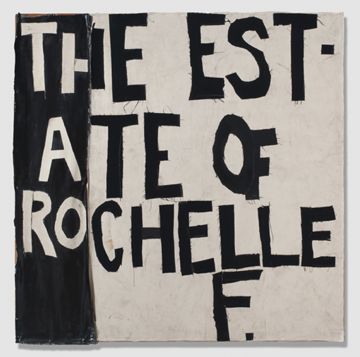
Rochelle Feinstein, "The Estate of Rochelle F.", 2009 Image: On Stellar Rays
This week’s post should really be titled “Rochelle Feinstein Teaching Me” but I’m trying to be consistent…
Prior to May 1st, please treat yourself and check out The Estate of Rochelle F. at On Stellar Rays. If Rochelle Feinstein is planning on retiring any time soon, this exhibition isn’t going to convince anyone that now is the right moment. Quite the opposite. Feinstein has created a body of new work from previous work and pieced together a series of paintings that in some ways resembles one my favorite assignments affectionately known as “Catharsis”: Take something you don’t like, or something you never finished, destroy it and put it back together in a new way. As the gallery website states:
The Estate of Rochelle F. began during the economic downturn of 2009, when Feinstein surveyed her studio’s assets, counting among these older stretchers, unfinished paintings, unused art supplies, and an assortment of other resources. Feinstein ventured to optimize these assets’ value by recombining the materials into a new body of work. In making The Estate, Feinstein 1) would not spend any additional money on this work, 2) would use any and all supplies as “assets,” and 3) would use maximal material and minimal gesture.
I met Rochelle Feinstein during my time at the School of the Art Institute of Chicago’s Teacher Institute for Contemporary Art (TICA) back in 2006 (by the way, the deadline was recently extended to apply for this summer) and was struck by her straightforward comments during the lunchtime slide presentation and in the studio visits that followed. The tough love, honesty and grit she shared during that visit is evident here, and as Ken Johnson recently said in his New York Times review, “Ms. Feinstein’s wry, melancholic art suggests that despair may be a fecund mother of invention.”
Works such as Mr. Please Please, Image of an Image, and Nude Model make me think about the freshness that lives in the studio when we reconsider what we have and perhaps what’s been discarded. Students (and even teachers… including myself) need to think about this! It’s an exercise more of us can afford to try. Rather than constantly looking for a new angle or new way of presenting our work, perhaps there is merit in re-exploring and/or rethinking the ideas or projects that never made it through new combinations? Students and teachers can also mine (as Marlene Dumas and others have put it) previous sketchbooks, plan books and journals as a way to explore projects and works that got “discarded” for one reason or another but now suggest new options.
As more and more artists begin to shun the studio and make a pitch for putting fewer objects on the planet, Rochelle Feinstein’s show is a reminder that we may just have a extraordinary (stellar!) collection of work under our nose if we take the time to look and push the material in different directions.